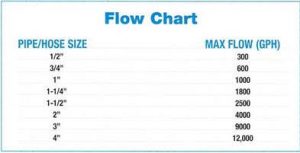Pond Pumps - Understanding the Basics
Pond pumps and plumbing make up the circulatory system of a water feature and are key to the aesthetics of your pond. More importantly, they supply the system with necessary oxygen levels and keep the water circulating.
Familiarize yourself with these terms as you get to know more about your pump.
GPH: The term “gallons per hour” represents how many gallons that pump is circulating every hour and can also be referred to as “rated flow.
Shut-Off Height: (Maximum Head Height): The higher a pump has to lift water, the less water it can deliver. I always define it as the height at which you will get out one drop of water on a good day with the wind at your back!
Head Height charts or graphs tell you exactly how much volume a pump will deliver at any given Head Height. You may see 2000 gph @ 5′ of Head. Please keep in mind that for a solid curtain of water coming over a ledge, you typically need about 1500 gph per foot.
Also as a general rule-of-thumb, the water needs to be “Turned” a minimum of once per hour but many prefer 1.5 to 2 times per hour. So a 2000 gallon pond requires AT LEAST a 2000 gph pump but many would use a 3000 or 4000 gph pump.
TDH: Total dynamic head refers to the pressure on a pump caused by the interactions of flow rate, pipe diameter, pipe length, elevation, and pipe material. Basically, it takes all those things into account and lets you know the limitation of your pump. TDH is usually calculated by a pond professional.
Operating Costs: The bigger your pump, the larger the operating cost per month. Pumps with high-efficiency motors can save money and deliver plenty of power. Aquasurge Pumps are a great choice for high quality and efficiency. For example, an Aquasurge 3000 which takes 160 watts to operate, at 10 cents a Kilowatt Hour will only cost about $11.68 a month
Plumbing Options: Using the wrong pipe can cause friction, hindering the performance of your pump and affecting the power of your waterfall. We recommend flexible PVC Pipe for pond projects. Please see chart below for the maximum amount of water that can physically fit through each size pipe regardless of the size and power of the pump:
Check Valve: Check valves help prevent water from draining back into the pond when the power to the pump is cut. You have to keep water in the biological filter so that the beneficial bacteria can continue to grow. Without the water, the bacteria can die and throw off the balance of your ecosystem.
About a third of the time people call us about their pumps being dead, it is actually the check valve that has failed. Most check valves have a little flapper that lets the water go up but slams shut when the pump is turned off. The little flapper in the check valve assembly is supposed to be loosely attached. When they fail, they break off inside the elbow and lodge themselves in the throat of the check valve. Your water flow will start to really slow down and if left will ultimately wedge itself in the throat and shut down the pump.
Try putting the pump in the water and turn on WITHOUT the check valve assembly attached. If the little flapper has broken loose inside the elbow, you can remove it using needle-nose pliers and a hacksaw blade held in your hand with a towel.
New for 2017- Dual Union Check Valve 2.0
 Posted on: Monday, July 10th, 2017 at 10:32 am
Posted on: Monday, July 10th, 2017 at 10:32 am  Pond News, Pond Tips.
Pond News, Pond Tips. You can follow any responses to this entry through the RSS 2.0 feed.
Both comments and pings are currently closed.
Comments are closed.
